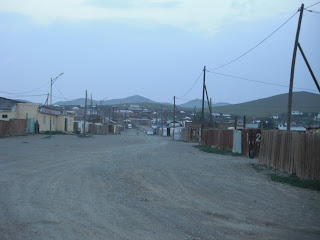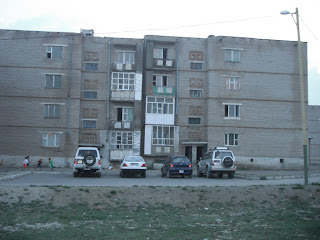 So a Horhog is a "Mongolian sheep roast", which typically takes place outside. The sheep, along with potatoes and carrots are put into a metal pressure cooker and many hot stones are placed inside it. Then the entire thing is put over a fire. The food is eaten by hand (everyone grabs a bone/hunk) and it is accompanied by large amounts of alcohol (typically vodka or airag [fermented mare's milk]). Yesterday, the PCT's had a family appreciation horhog in a neighboring park. The picture to the left is the meat when it comes out of the cooker. I'm pretty sure that I was eating a shoulder bone yesterday. The locals eat everything (including the marrow, fat, ligaments), but I only ate the meat.
So a Horhog is a "Mongolian sheep roast", which typically takes place outside. The sheep, along with potatoes and carrots are put into a metal pressure cooker and many hot stones are placed inside it. Then the entire thing is put over a fire. The food is eaten by hand (everyone grabs a bone/hunk) and it is accompanied by large amounts of alcohol (typically vodka or airag [fermented mare's milk]). Yesterday, the PCT's had a family appreciation horhog in a neighboring park. The picture to the left is the meat when it comes out of the cooker. I'm pretty sure that I was eating a shoulder bone yesterday. The locals eat everything (including the marrow, fat, ligaments), but I only ate the meat.Below is a picture of Ashley with her host mom (Shuree, with hat), along with a fellow trainee Kate and her host mom. The picture below that is of Justin with his host sister, Booya.

 So, the order of a horhog is:
So, the order of a horhog is:1) hot rocks are removed and passed around for good luck (very greasy and VERY hot)
2) soup cups are passed around which consist of the liquid drained from the cooker
3) meat is pulled out and put into a large bowl
4) meat bowl is passed around and everyone grabs a hunk
5) bread is passed around, along with any other sides (watermelon, carrots, etc)
6) vodka is opened and all adults are expected to take at least one small cup (a few shots). Repeat this step until all vodka is finished
7) candy is passed around

The picture to the right is of most the Peace Corps guys from our town (8 of 13).
After we played frisbee and volleyball, we walked back to town, about 4 miles. On the way back to town, we passed many herds of animals, including cows, horses, sheep, and goats. There are a lot of babies this time of year
 .
.Then, we walked through one of the neighboring ger districts (known as a hashaa district) on the way back to our houses. Each family typically has a plot of land that is surrounded by a wooden/metal fence. Each fence typically has 1 or 2 swinging doors and 1 car door. This fenced off area is called a hashaa and many of them have a dog for security. Though they may look rough from the outside, many of the gers/houses are very nice inside. People living in hashaas typically do not have running water (fetch it from the waterman via barrel) and most have outhouses. Our friend Tim's family's ger has a tv, fridge, and sound system.
 Lastly, we arrived at Ashley's
Lastly, we arrived at Ashley'sapartment building, picture below left.


No comments:
Post a Comment